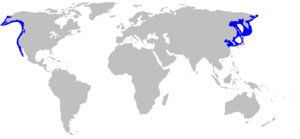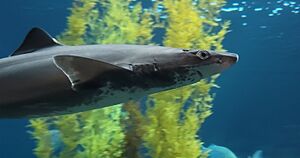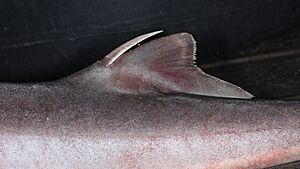Pacific spiny dogfish facts for kids
Quick facts for kids Pacific spiny dogfish |
|
|---|---|
 |
|
| Conservation status | |
| Scientific classification | |
| Genus: |
Squalus
|
| Species: |
suckleyi
|
 |
|
| Locations of Squalus suckleyi in the Pacific. | |
The Pacific spiny dogfish (Squalus suckleyi) is a common type of shark that belongs to the Squalidae family, also known as dogfish. These sharks are some of the most common sharks found around the world. For a long time, scientists thought the Pacific spiny dogfish was the same as another shark called Squalus acanthias. But new studies show they are actually different species! It's officially called the "Pacific spiny dogfish".
These sharks can grow up to 130 centimetres (51 in) long and can live for an amazing 100 years! Pacific spiny dogfish grow slower, get bigger, and become adults later than Squalus acanthias. Their slower growth might be because they live in colder waters, preferring temperatures from 7 to 15 °C (45 to 59 °F). While dogfish are found worldwide, the Pacific spiny dogfish lives mainly in the North Pacific Ocean. This includes areas from Korea, Japan, and Russia, all the way to the Gulf of Alaska and down to Baja, California. They are piscivores, meaning they eat other fish. They also enjoy eating octopus, squid, and crustaceans like crabs.
Pacific spiny dogfish reproduce slowly compared to other sharks. Their pregnancy lasts about two years. This slow reproduction rate makes them more vulnerable to threats, as it takes them a long time to have new babies.
Contents
About the Pacific Spiny Dogfish
Size and How Long They Live
Pacific spiny dogfish are small and slender sharks. Across the Pacific Ocean, both male and female dogfish usually measure between 100 and 130 centimeters long. When they are fully grown, female Pacific dogfish can weigh about 15 to 20 pounds. Males tend to be much smaller. These sharks usually become adults around 25 years old. They can live to be 100 years old, making the Northeast Pacific spiny dogfish the longest-living dogfish species!
What They Look Like

The Pacific spiny dogfish has a unique look with its special snout, large eyes, and flat head. Its body is shaped like a cylinder. This shark also has a distinct color pattern. The top half of its body is gray with scattered white spots, while the bottom half is white or light gray.
Their skin is covered in tiny, tooth-like dermal denticles, which are made of the same material as shark teeth. This makes their skin very tough and strong. In the past, dried shark skin was even used like sandpaper for woodworking or as a type of leather after the denticles were removed.
The Pacific spiny dogfish has flat teeth with sharp edges, which are perfect for grinding food instead of tearing it. If any teeth get worn down or break, new ones grow in from the two rows of teeth behind them.
Spines and Fins
A special feature of this shark is its fins. Unlike many fish, the Pacific spiny dogfish does not have an anal fin. However, it has two sharp spines, one in front of each dorsal fin. These spines are used for protection against enemies like other sharks, humans, and even whales. The spines are known to be venomous, though scientists are still studying the venom. This is why they are called "spiny" dogfish! When threatened, the shark can curl up into a ball and use these spines to defend itself.
The dorsal spines also have rings on their enamel, which can help scientists guess the shark's age. The dorsal fins also help the shark swim. The first dorsal fin helps the dogfish stay stable in the water, while the second one helps it move forward. Its tail fin (caudal fin) is larger than usual, which helps the shark swim quickly and efficiently through the water.
Gills and Breathing
The Pacific spiny dogfish has a unique way of breathing. It has five gills on each side of its head, but unlike bony fish, it doesn't have gill covers. The shark breathes by swimming or by staying in a water current.
It also has a special feature called a spiracle. These are small openings behind the shark's eyes that bring oxygen to its eyes and brain. The spiracle is also used for breathing when the shark is resting or eating.
The dogfish breathes in a two-step process. First, water enters its mouth and flows out through its gill slits. The first three gill slits are mainly used for sucking in water. The fourth gill slit does the same but with less force. The fifth gill slit lets water escape while the Pacific spiny dogfish is eating.
Where They Live
Ocean Home
Dogfish sharks generally live in three main parts of the ocean: the Pacific, Atlantic, and Indian oceans. While dogfish can be found all over the world, the Pacific spiny dogfish specifically lives in the Pacific Ocean. Scientists recently confirmed that the spiny dogfish in the northern Pacific Ocean are a separate species, now known as the Pacific spiny dogfish.
Natural Habitat
The Pacific dogfish lives in bays, both close to shore (inshore) and further out in the ocean (offshore). Female dogfish are often seen closer to shore, while small baby sharks, called pups, are found in offshore waters. These animals are usually found near the bottom of the continental shelf, which is the edge of the landmass under the sea. The Pacific dogfish prefers to live mainly in saltwater, but they can also live in and handle brackish water, which is a mix of salt and fresh water.
Migration and Travel
Scientists are still learning about how Pacific spiny dogfish migrate. Studies of tagged dogfish show that they travel north and south along the west coast of the United States and Canada during different seasons. Dogfish tagged in the Puget Sound often leave that area for coastal waters in the summer.
Some tagged dogfish released in Canadian waters near British Columbia were later found near Japan! This suggests that these sharks might travel across the open ocean, more than 1000 km from shore, instead of just following the coast.
Reproduction and Life Cycle
The Pacific dogfish has a longer reproduction time compared to other sharks. Their pregnancy, or gestation period, usually lasts from 18 to 24 months. Dogfish living in colder water might have even longer pregnancies. Female sharks are known to move from deep water to shallow water as their pregnancy continues. This move seems to help the baby sharks grow. For example, baby dogfish near Newfoundland grew about 1.1 cm per month during a 24-month pregnancy. In a warmer area like Massachusetts, they grew about 1.3 cm per month during a 20-22 month pregnancy.
It's hard to tell exactly when a dogfish becomes sexually mature because it can vary from 10 to 30 years old. How much food is available and the water temperature also affect how fast dogfish grow and develop. A newborn Pacific dogfish is usually around 22 to 23 centimeters long. Female dogfish are significantly larger than males. When they reach sexual maturity, males are about 60–70 cm long, while females are about 70–100 cm. This size difference in females helps them carry and protect their eggs inside their bodies.
Pacific dogfish are ovoviviparous. This means they produce eggs that hatch inside the mother's body, and then live young are born. A female can have anywhere from 1 to 20 babies at a time. Fertilization usually happens between early October and early February.
What They Eat
The Pacific dogfish is an elasmobranch, which is a type of fish with cartilage instead of bones, like sharks, skates, and rays. Dogfish are carnivorous, meaning they are meat-eaters. Their teeth are sharp and angled sideways, which helps them cut through their prey.
The Pacific dogfish usually eats mollusks and crustaceans, such as squid, krill, and shrimp. They also eat other small sharks and fish. Scientists have found that male and female dogfish eat the same kinds of food. Their prey is often found on the sea floor, so the Pacific spiny dogfish scans the bottom to find its meals.
Elasmobranchs eat very few carbohydrates and sugars. If they don't have enough food, they use special energy sources called ketone bodies to survive. Cartilaginous fish can handle very low blood sugar levels because they are good at using ketones for energy. However, Squalus suckleyi can eat more carbohydrates than other elasmobranchs. When a dogfish eats, a special gland called the rectal gland becomes active. This gland helps the Pacific dogfish use a small amount of sugar for energy.
Threats to Dogfish
Threats from Other Animals
The main animals that threaten the Pacific dogfish population are larger sharks, Killer whales, seals, and bigger bony fishes. The Pacific dogfish has relatively few predators because its poisonous spines help keep enemies away. The Giant Pacific Octopus has also been found to hunt them in the wild.
Threats from Humans

Because Pacific spiny dogfish grow slowly and have few babies, they can be easily harmed by overfishing. However, unlike the spiny dogfish found in other parts of the world, which have been overfished in the past, studies for the Pacific spiny dogfish in Alaska, British Columbia, and the West Coast of the United States show that their numbers are stable and they are not currently being overfished.
For hundreds of years, people on the Pacific coast have caught dogfish for food and for their skin, which was used for polishing. Commercial fishing for dogfish began in the 1930s. The most Pacific spiny dogfish were caught in the 1940s because there was a high demand for Vitamin A from shark liver oil. It's estimated that over 15,000 metric tons were caught in 1944, but this number quickly dropped after that and has stayed below 3,000 metric tons since 1950.





